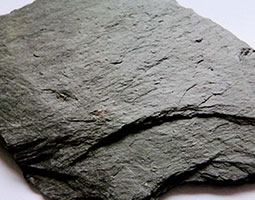Description

Slate is a fine-grained, foliated metamorphic rock that is created by the alteration of shale or mudstone by low-grade regional metamorphism. It is popular for a wide variety of uses such as roofing and flooring because of its durability and attractive appearance. The tectonic environment for producing slate is usually a former sedimentary basin that becomes involved in a convergent plate boundary. Shales and mudstones in that basin are compressed by horizontal forces with minor heating. These forces and heat modify the clay minerals in the shale and mudstone forming slate.
Uses
Most of the slate mined throughout the world is used to produce roofing slates. Slate performs well in this application because it can be cut into thin sheets, absorbs minimal moisture, and stands up well in contact with freezing water. A disadvantage is the cost of the slate and its installation in comparison with other roofing materials As a result, in new construction slate is mainly confined to high-end projects and prestige architecture.
Slate is also used for interior flooring, exterior paving, dimension stone, and decorative aggregate. Historically slate has been used for chalkboards, student writing slates, billiard tables, cemetery markers and table tops.
Sources